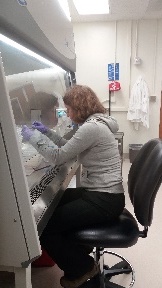In May’s Junior Researcher Feature, we have an interview with Dr. Tamsin Spelman, Research Associate in the Sainsbury Laboratory, University of Cambridge.

When did you first become interested in mathematics and biology?
I loved mathematics from early schooling, but it was well into my mathematics Ph.D., and even my first postdoc, before I started to appreciate how fascinating biology is as well. My Ph.D. was on artificial microswimmers supervised by Prof. Eric Lauga (Cambridge, UK), and with most of the other group members focussing on biological microscale systems, I was introduced to many different biological problems. However, it was a postdoc with Dr. Peter Stewart (Glasgow, UK) on retinal blood flow with its direct medical applications which showed me how important mathematics is to real world biological questions and their wider societal implications. Having now spent 3 years working in a plant science research lab in the group of Prof. Henrik Jonsson (Cambridge, UK), I am a definite convert to mathematical biology.
Was the decision to do a Ph.D. an obvious and easy choice?
I greatly enjoyed my mathematics undergraduate degree, so continuing to a Ph.D. afterwards seemed the obvious choice. However, I found it challenging studying for finals while also trying to determine who, where, and what I wanted to do a Ph.D. in. By good fortune I ended up working with Prof. Eric Lauga, and I would strongly recommend to anyone considering a Ph.D. not to underestimate the importance of finding a supervisor you can get along well with.
What are the main biological research questions that you are interested in?
I am interested in small scale biology, focussing at both the cell and organ scale. At the cell level I want to understand organelle transport in single cells, particularly how mechanical forces balance each other and local organelle properties explain the myriad of observations. Organelle motion is essential for healthy organism development; as a specific example, nucleus movement is necessary for cell division, fertilization etc. At the organ level, I am focusing on the human eye aiming to use mechanical and fluid modelling to inform diagnosis and treatment of eye injuries and diseases. I have ongoing projects with Dr. Peter Stewart and the UK Special Interest Group (SIG) on Mathematically Modelling of the Eye.
What types of questions do you think will be important to answer in the future in your field?
Open questions in plant cell biology include, for example, how the cytoskeleton is involved in mechanosensing, how cells detect and respond to external stimuli, and if/how signalling occurs from the vacuole to the nucleus, which is interesting due to the importance of both these organelles to many cell functions and cell development. These and more are discussed in a fantastic paper outlining Fifteen compelling open questions in plant cell biology. Biology is very complex, so there are huge numbers of unanswered questions, many of which we don’t yet know to ask, but will keep mathematical biologists busy.
What mathematical and computational tools do you find useful in your work?
Recently, I have relied on and helped develop large open-source C++ code to model the cytoskeleton. However, it is always very satisfying when we can capture the dominant behaviours with reduced mathematical models, for example, mean-field theory for 3D microtubule alignment and 1D ODEs for nucleus motion. I believe cross-comparing between computational and mathematical models produces the strongest results, particularly when also combined with experiments. I have enjoyed collaborating with experimentalists and have thrown myself into short experimental projects which I found very insightful to understand the practical challenges and limitations.

Experimental work at the "Form, Fate, and Function" summer school at KITP, Santa Barbara, USA.
How would you describe the results of a recent paper you contributed to?
We showed the importance of geometry control for microtubule organisation, comparing experimental results of Dr. Pauline Durand-Smet in plant protoplast cells placed in shaped microwells to my microtubule simulations (see example simulation above). Additionally, we demonstrated the importance of the cross-over severing protein katanin to this organisation both experimentally and computationally. The paper is published in PNAS: “Cytoskeletal organisation in isolated plant cells under geometry control” by P. Durand-Smet, T. A. Spelman, E. M. Meyerowitz and H. Jönsson.
What makes you passionate about your work?
The long-term critical applications, even when they seem far away from the equation in front of me. We need to develop new crop strains resistant to the effects of climate change and to provide food security, and for that we need our fundamental understanding of plants, which is where my research comes in. On a day-to-day basis, biology has many fascinating behaviours making every conversation interesting.
What do you like to do in your spare time outside of work?
My hobbies are taekwondo, board games and horse riding. A nice cycle after work in the summer sun also never goes amiss, before relaxing with our pet rabbits in the garden.
